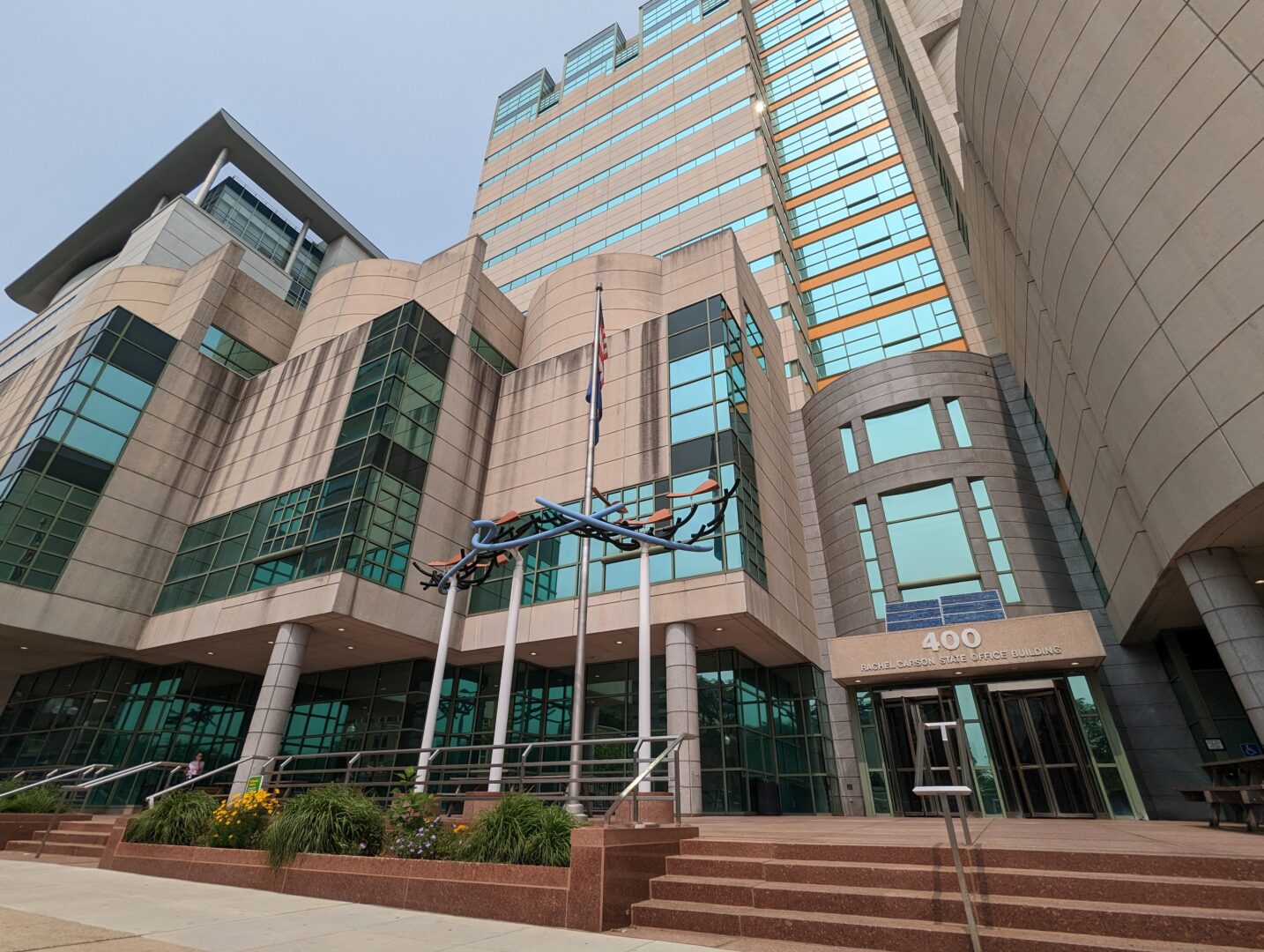
The Rachel Carson Building where the Pennsylvania Department of Environmental Protection offices are located. in Harrisburg.
Jeremy Long / WITF

The Rachel Carson Building where the Pennsylvania Department of Environmental Protection offices are located. in Harrisburg.
Jeremy Long / WITF

Jeremy Long / WITF
The Rachel Carson Building where the Pennsylvania Department of Environmental Protection offices are located. in Harrisburg.
Pennsylvania’s communities could get up to $4.6 billion for climate pollution reduction, according to the state’s Department of Environmental Protection (DEP).
Since June, the DEP has been drafting a Priority Climate Action Plan (PCAP) for the U.S. Environmental Protection Agency (EPA). That plan will lay out the state’s strategies for reducing climate change – especially from the industrial sector. Their plan is due to the EPA on Mar. 1, but the DEP said in mid-Dec. that they need residents to shape statewide initiatives.
Lindsay Byron, DEP’s Environmental Group manager, is one of their plan writers. She explained how the state’s plan will allow local governments and organizations to apply to the EPA for a piece of that $4.6 billion grant. Communities from across the nation can apply to the EPA’s Climate Pollution Reduction Grant, but all applications must address at least one initiative laid out in their state’s Priority Action Plan.
Byron urged communities to reach out to her and the DEP as soon as possible if they are planning on applying to the grant. The grant is highly competitive, she said at an informational meeting in Wysox, Pa.
“As soon as municipalities, local governments, any potential applicants for the EPA implementation grants – as soon as they know what measures they want to fund with those grants – they need to let me know. I need to be able to include that in the state’s Priority Action Climate Plan in order for it to be eligible for funding by the EPA,” said Byron.
Communities do not need to submit their full project to the DEP, but they need to show how their project would benefit the environment. Byron asked organizations to send in at least an idea of what their project would be by Feb. 1, so the DEP can include their input before the March deadline.
As long as projects address climate change, the DEP’s Colleen Unroe said they could cover anything. She is their William and Hannah Penn Fellow, and works in their Energy Programs Office on clean energy initiatives.
“Those projects can be anything ranging from helping to support energy efficiency projects, supporting solar projects – a whole variety of ways to reducing greenhouse gas emissions,” said Unroe.
Potential applicants are sending in a range of ideas to DEP, from upgrading weatherization features to installing electric vehicle charging stations in their communities.
However, communities have limited time to send in their applications to the EPA. Proposals are due by Apr. 1, 2024 – only a month after DEP’s deadline to submit their Priority Climate Action Plan. Byron recommends that smaller local governments and organizations form coalitions to share resources to meet that fast-approaching April deadline.
“One of the big things that I’m hearing repeatedly in all kinds of communities, from urban to rural – like up here, is the ability for these local governments to actually apply to these grants,” said Byron. “Like, folks are saying here, they don’t have grant writers or they do have grant writers, but they have limited capacity. And the timeline? It’s a real challenge.”
While Byron hopes residents will send in their ideas a month before DEP turns in the state’s PCAP, most local governments have already had or are about to have their last meeting of the year. That leaves most municipalities with few regularly scheduled public meetings before her requested date and the March deadline.
However, DEP’s Unroe is optimistic about the grant’s potential to mobilize communities against climate change.
“Which feels in some regards overwhelming. And, maybe people might not have hope that they can make change. But this is a tangible way that folks can see change in their local communities,” said Unroe.
Residents, whether or not they are part of a coalition submitting a grant application, can inform the DEP’s action plan at their Climate Opinion Survey. For more information on the EPA’s Climate Pollution Reduction Grants, go to theirwebpage.

A collection of interviews, photos, and music videos, featuring local musicians who have stopped by the WITF performance studio to share a little discussion and sound. Produced by WITF’s Joe Ulrich.
The days of journalism’s one-way street of simply producing stories for the public have long been over. Now, it’s time to find better ways to interact with you and ensure we meet your high standards of what a credible media organization should be.